London and South Western Railway Servants' Orphanage, Clapham / Woking, Surrey
The London and South Western Railway Servants' Orphanage was founded in 1884 by the Rev. Canon Allen Edwards, Vicar of All Saints, South Lambeth, also known as the 'Railwaymen's Parson'. At this date, the only existing orphanage for the children of railway workers was the one at Derby which had opened in 1875 and where several orphans of LSWR workers had been admitted. By 1883, however, the Derby orphanage was reported as being almost full. Shortly afterwards, the Rev. Edwards began raising funds for an orphanage for the 'fatherless children of Railway Servants of every grade at all stations served by the London and South Western Line'. Money was raised both from within the company and also from outside contributions.
The orphanage, based in a house on Jeffrey's Road, Clapham, opened its doors in March 1886, initially just taking girls. Ten were admitted at the outset, followed by a further eight children the following October. As was usually the case in such institutions, the applicants for admission to the home were chosen by a ballot of the charity's subscribers, who were allowed one vote for each five shilling donation they made. The charity was managed by a Board composed of railway men representing practically every grade in the company.
In 1894, increasing demand for places at the home led to the acquisition of a neighbouring house, taking the accommodation up to fifty girls. Two years later, a further property was occupied in which 26 boys were housed. The orphanage then extended from number 76 to number 80, Jeffrey's Road. Eventually, in 1900, the girls were moved to a large house at 20 Guildford Road, South Lambeth.
In 1909, the continuing pressure on places at the home led to its moving to new purpose-built premises on Oriental Road, Woking. The seven-acre site was bought from the London Necropolis Company at a cost of £2,800. The new building, whose construction cost a further £24,000 was designed by Mr E.C. Hughes of Wokingham. Its foundation stone was laid in October 1907 by the Duchess of Albany.
The orphanage's site at Woking is shown on the 1935 map below.
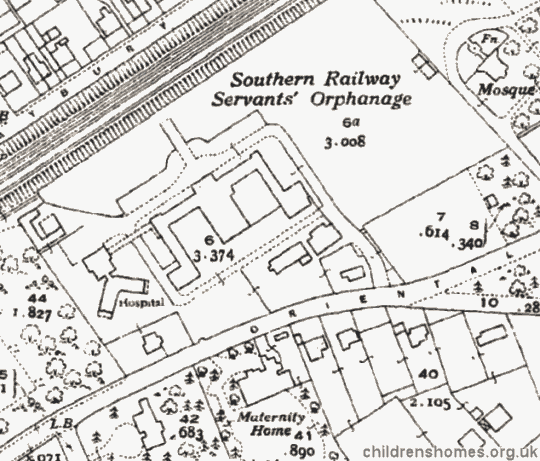
LSWR Orphanage site, Clapham, c.1935.

LSWR Orphanage, Woking, aerial view from the south, date unknown. © Peter Higginbotham

LSWR Orphanage, Woking, main building from the west, c.1909. © Peter Higginbotham
The new home was built from brick and stone. At the front, which faced the main railway line to London, were a semicircular porch and Ionic columns, with a richly carved shield at the top bearing the inscription 'Founded by Canon Allen Edwards, 1885' filled in with glass gold mosaic. The building was 220 feet wide, with two wings running back a distance of 128 feet. It could accommodate up to 150 children, with 108 children initially being transferred from the old London houses.
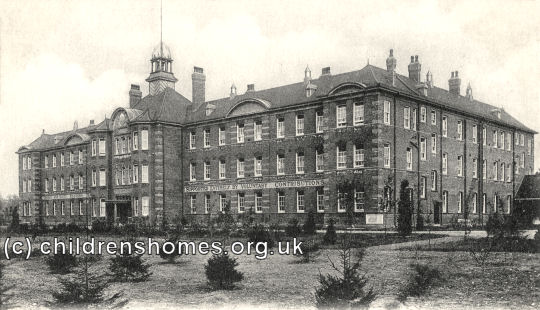
LSWR Orphanage, Woking, main building from the west, c.1914. © Peter Higginbotham
The Duchess of Albany returned to perform the official opening at a grand ceremony on 5th July 1909. A guard of honour was provided the 2nd Battalion Royal Irish Rifles, and about fifty of the home's children were formed up near the entrance. The boys were dressed in dark grey Norfolk suits with felt hats and red ties, and the girls wore neat dresses of dark blue, with grey straw hats trimmed with blue, and a white riband round the neck. The Duchess opened the building with a large gold key — the gift of the architect — and then inspected the principal rooms.
The occasion provided an opportunity for some much needed fund-raising, with £5,000 still needed to pay off the building and ongoing running costs in the order of £50 per week. The Duchess received donations in purses whose contents amounted to around £450, the largest being £60 from the Locomotive Department, Nine Elms, and £53. 7s from the Woking Local Committee. There were nine railway dogs on the premises making their dumb appeal, and 'Woking Bill' amassed over £7 during the afternoon.
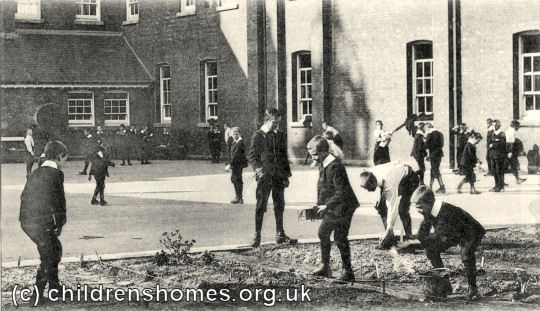
LSWR Orphanage, Woking, boys' playground, c.1914. © Peter Higginbotham
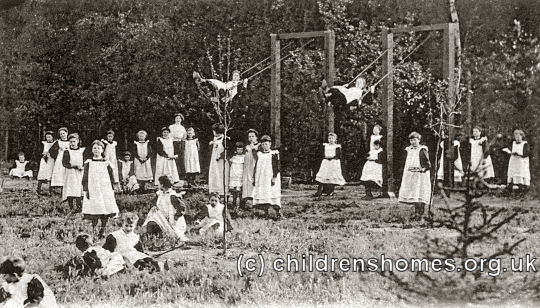
LSWR Orphanage, Woking, children at play, c.1914. © Peter Higginbotham
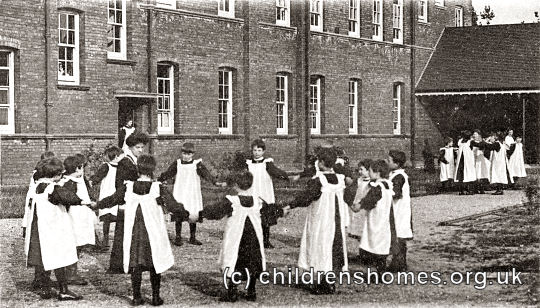
LSWR Orphanage, Woking, girls playing ring-a-roses, c.1914. © Peter Higginbotham
Facilities eventually provided at the home included a hospital block, laundry, gymnasium, large library, workshops and stables. A boys' gymnastic squad performed displays of their skills.

LSWR Orphanage, Woking, children at play, c.1914. © Peter Higginbotham

LSWR Orphanage, Woking, children at play, c.1914. © Peter Higginbotham
Around three-quarters of the funds needed to run the home came the railway's own employees were were encouraged to make a weekly contribution of 2d or 3d. The railway also had its own team of dogs with collection boxes to gather donations at stations and on trains. A medal was awarded to each dog for each year's service. After death, the animals were stuffed and displayed at their home stations so that they could continue collecting.
In 1923, following a national grouping of smaller railway companies, the orphanage became the Railway Servants' Orphanage.
In 1935, a new wing was added along the whole southern side of the main building, blocking off the original its open 'E' shape. Two properties at the opposite side of Oriental Road also became part of the establishment. The smaller of the two, Brantwood, was used as a nursery.
During the Second World War, the children were evacuated and the site was taken over by St Thomas's Hospital. When things returned to normal after the war, part of the premises were then taken over as a retirement home for rail personnel, with the whole establishment officially known as the Southern Railwaymen's Homes for Children and Old People.
In the mid-1960s, the children's section was renamed Woking Grange. In the mid-1980s, the care of children at the site ended. During its century or so of operation, around 3,500 children were cared for over at the home. Today, the site is simply known as Woking Homes, provided residential care for elderly former railway staff.
The orphanage buildings no longer exist.
Records
Note: many repositories impose a closure period of up to 100 years for records identifying individuals. Before travelling a long distance, always check that the records you want to consult will be available.
- Surrey History Centre, 130 Goldsworth Road, Woking, Surrey GU21 6ND. Has a variety of material for the period 1875(!) to the 1990s including printed items, photographs, audio recordings, archive film etc. and also a copy of the orphanage's admission registers.
- Woking Homes still retains the home's original archives. For access contact: Mrs Chris Orchard, Woking Homes, Oriental Road, Woking, Surrey GU22 7BE
Bibliography
- Blog article on the LSWR Orphanage By David Turner.
Links
- Woking Grange website for former children and staff. Includes a history of the institution.
- Children's Railway Home — colour film 1960.
- 'The Southern Railway Servants' Orphanage at Woking' — B&W film c.1926.
- 'Only Once A Year' — B&W film c.1932.
- 'Southern Railway Orphanage — Life at the Home' — colour film c.1952
- 'Blue Peter: Handing Over a Puppy' — colour film c.1952
Except where indicated, this page () © Peter Higginbotham. Contents may not be reproduced without permission.


